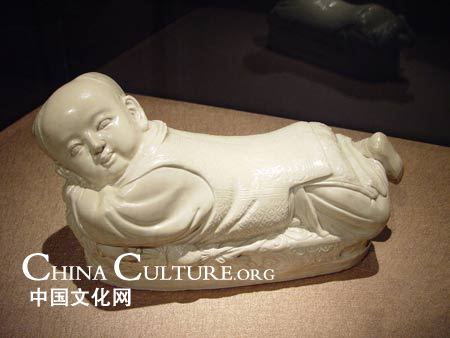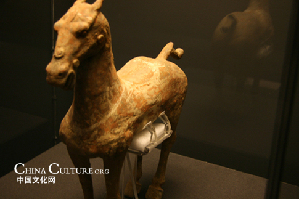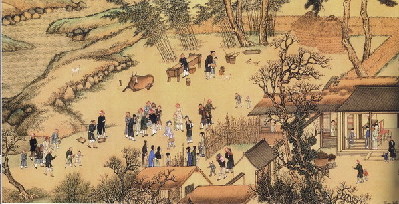| Home > Living in China > Art |
The Magic of Chinese
One of the world’s oldest languages appears to have a vibrant future
By AN ZI

|
| CHINESE OPPORTUNITY: A Confucius Institute is inaugurated in Pakistan. More than 60 Confucius Institutes have opened in more than 30 countries and regions worldwide |
Classical Greek and Latin, two languages that share an ancient history with Chinese, have been threatened with extinction, being used primarily in classic books or for special purposes. Chinese, on the other hand, is thriving as more and more people develop an interest in learning the language, and its charm has been noticed by linguists.
Some 30 years ago, a popular theory predicted, ?EM>Pinyin (the phonetic system for transcribing Chinese characters) will replace characters,?since English words could be typed on a computer but Chinese characters could not. That has changed in the ensuing years, however, with the development of Chinese character computer keyboards, and pinyin has not replaced characters. And as technology improves, it is much faster to type Chinese characters on a keyboard than English words.
As Chinese characters have a 5,000-year history, they have developed into a steady system that contains enormous information. A person has to remember only about 10,000 Chinese characters in his lifetime. China’s national standard for literacy is knowledge of 1,500 characters, while for college students majoring in science and engineering, 2,000 are enough. Those 2,000 characters enable one to read and do scientific research.
In the time of William Shakespeare (1564-1616), there were about 30,000 English words. Shakespeare had a good command of the language and thus left a tremendous legacy. But as new ideas, products and discoveries were made, the number of English words swelled. Therefore, no one today can match Shakespeare in English proficiency. There is still no clear answer to the question of how many English words one needs to master to be literate.
According to linguists, an educated English speaker should have command of about 50,000-250,000 words. One needs to know 20,000 words to read a newspaper.
Chinese students typically have to pass several English tests to study abroad. One of them, the Test of English as a Foreign Language (TOEFL), offered by the U.S.-based Educational Testing Service, requires a vocabulary of 8,000-10,000 words. The Graduate Record Examination (GRE), required for admission to many graduate schools, requires a vocabulary of 10,000-20,000 words.
The International English Language Testing System, sponsored by Cambridge University, the British Council and IDP Education Australia, doesn’t stipulate a required vocabulary but primarily measures the ability to communicate in English across all four language skills--listening, reading, writing and speaking--for people who intend to study or work where English is the language of communication.
In China, college students are required to know about 5,000-6,000 English words. For English majors, the highest standard is 10,000 words. But for Chinese students, meeting that standard is much harder than mastering 10,000 Chinese characters.
A study in contrasts
One paragraph of The Magical Chinese, an article circulating on the Internet, highlights the differences between the two languages. The author, a Chinese student studying at a foreign university, asked several professors at the university to define “cuboid,?but he was disappointed that none of these native speakers knew the word. He continued to ask several American graduate students, but he was disappointed again. Later, the Chinese student looked up the word in a dictionary but forgot its meaning soon after because he seldom used it. He came to realize that it is difficult for the English language to come up with words for everything new in the world since in that case the number of new words would be endless. In contrast, the Chinese language avoids the problem because it uses existing characters to name new things, making the new words easy to understand.
According to statistics, there are more than 400,000 English words in use currently, and the number is predicted to top 1 million soon. But the number of Chinese characters is comparatively steadier. At present, middle school students in China are still able to read the poetry of Qu Yuan (340-227 B.C.), one of China’s earliest poets. But because of the more rapid changes in the English language over the centuries, it is difficult for those proficient in English to read the original works of Shakespeare, not to mention the sonnets of Geoffrey Chaucer, the British poet who wrote The Canterbury Tales more than 600 years ago.
But the Chinese language also faces problems. While studying English is a fad in China, Chinese students?ability to write in their native language is worsening; that even includes young people with a strong educational background.
In the meantime, Chinese language study is booming around the world. Currently about 2,300 universities in more than 100 countries offer Chinese courses. The number of foreigners studying Chinese has surpassed 30 million, making Chinese the language with the fastest growing number of learners.
Major countries around the world are all paying attention to promoting their mother tongues and regard that as a national strategy. For example, the United States and Britain have invested enormous amounts of money in popularizing English, and France has established over 1,000 French federation branches in 138 countries.
The Chinese Government is promoting Chinese through the founding of Confucius Institutes, named for the renowned Chinese philosopher and educator dating back 2,500 years. The first Confucius Institute was set up in South Korea in November 2004. So far, over 60 institutes exist in more than 30 countries and regions.
Art
 more
moreClassic Chinese Handicraft:
Porcelain pillows, as classic Chinese handicraft,

Chinese Treasures Returned from
As witness of Chinese culture and custom, countless treasures

The lost legacy: classical music
Accompany by the long history of China, Chinese classical music

Customs
 more
moreChinese Kungfu
Kungfu Taste: Learn Martial Art in Shaolin Temple
The mention of Shaolin Temple conjures up images of a quiet and
Keet Kune Do will reappears on screen: BRUCE Lee and
The Legend of Bruce Lee is shot by China Central Television
The Road to the Olympic Games for Wushu
Wushu, also called kungfu, martial arts, is attracting more and more




 print
print  email
email  Favorite
Favorite  Transtlate
Transtlate 
